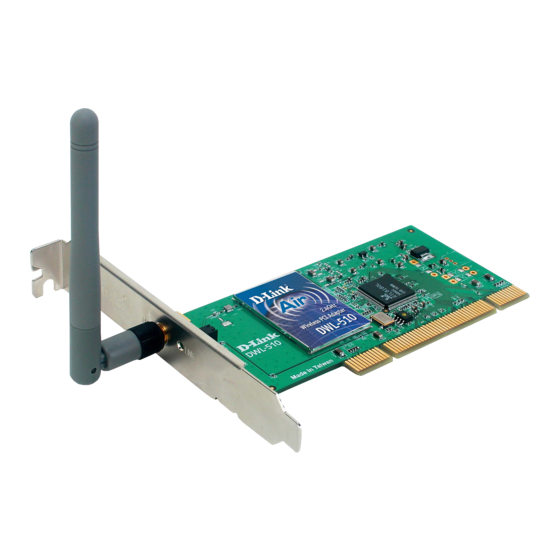
Table of Contents
Advertisement
Quick Links
Advertisement
Table of Contents

Summary of Contents for D-Link DWL-510A1
- Page 1 IEEE 802.11b Wireless PCI Adapter User’s Guide...
- Page 2 USA-FCC (Federal Communications Commission) statement This device complies with Part 15 of the FCC Rules. Operation is subject to the following two conditions: (1) This device may not cause harmful interference, and (2) This device must accept any interference received, including interference that may cause undesired operation 15.21 CAUTION: Any changes or modifications not expressly...
- Page 3 ---Consult the dealer or an experienced radio/TV technician for help. Caution Statement of the FCC Radio Frequency Exposure This Wireless LAN radio device has been evaluated under FCC Bulletin OET 65C and found compliant to the requirements as set forth in CFR 47 Sections 2.1091, 2.1093, and 15.247(b)(4) addressing RF Exposure from radio frequency devices.
- Page 4 MPE Statement (Safety Information) Your device contains a low power transmitter. When device is transmitted it sends out Radio Frequency (RF) signal. Safety Information CAUTION: To maintain compliance with FCC’s RF exposure guidelines, this equipment should be installed and operated with minimum distance 20 cm between the radiator and your body.
- Page 5 INTRODUCTION Congratulations on your purchase of this IEEE 802.11b WLAN PCI Adapter. This manual helps to get familiar with the WLAN PCI Adapter. This manual contains detailed instructions in operation of this product. Please keep this manual for future reference. With a WLAN (IEEE 802.11b) PCI Adapter, a desktop computer or a station can communicate with another computer in a wireless way.
-
Page 6: Unpacking And Setup
UNPACKING AND SETUP This chapter provides unpacking and setup information for the WLAN PCI Adapter. Unpacking Open the box of the WLAN PCI Adapter and carefully unpack it. The box should contain the following items: One 802.11b WLAN PCI Adapter One Driver &... -
Page 7: Hardware Installation
HARDWARE INSTALLATION LED Indicator LNK (LINK) The LNK indicator lights green when the WLAN PCI Adapter is connected to a network successfully. Otherwise the LNK indicator remains off while the W LAN is scanning the wireless devices. Installing the WLAN PCI Adapter 1. -
Page 8: Software Installation
SOFTWARE INSTALLATION This section will lead you to install the driver and utility of the WLAN PCI Adapter Driver Installation Once the WLAN PCI Adapter was installed into your computer’s PCI slot, the Windows OS will auto detect a new device and need to install the driver. -
Page 9: Windows 98/Me/2000/Xp Wlan Utility Installation
Windows 98/ME/2000/XP WLAN Utility Installation Insert the WLAN PCI Adapter Driver & Utility CD-ROM into computer’s CD-ROM Drive and it will automatically run a setup menu. In some specific setting on Windows system, you may need to proceed the software manually, press the Windows Start →... -
Page 10: Wlan Utility Setting
WLAN Utility Setting With the WLAN PCI Adapter utility, users can configure all the functions provided by the WLAN Monitor Utility. Double -click the utility icon that appears in the taskbar. The WLAN Monitor Utility includes four tabs: Configuration, Link State, Security and Statistics. - Page 11 Ø Channel: It shows radio channel numbers that used for WLAN networking. The channel number can be set only under the Ad-Hoc operation mode. In Ad-Hoc mode stations, each station must have the same channel numbers and SSID. In Infrastructure mode, the WLAN PCI Adapter will automatically detect the channel number of the Access Point.
- Page 12 Ø RTS: The RTS/CTS Threshold is a station initiates the process by sending a RTS frame , the other ends receives the RTS and responds with a CTS frame, the station must receive a CTS frame before sending the data frame.
- Page 13 Link State As you enter the Link State screen, you will see the current setting. To rescan the signal between the wireless station and your WLAN PCI Adapter, click the “Rescan” button. To display the detail information, click on the “Detail” button. The Signal Strength and Signal Quality will be shown in the screen below under the Link State of the utility,...
- Page 14 Ø Site Survey The screen shows all the messages of Wireless devices around your Wireless PCI Adapter. The messages of the wireless devices include Network Type, SSID, BSSID and the Signal. You can click the Refresh button to find the new wireless devices, and then you can double-click the BSSID to choose the wireless station that you want to connect.
- Page 15 Security This function is used to protect wireless communication from eavesdropping. A secondary function of encryption is to prevent unauthorized access to a wireless network, and it can be achieved by using the Encryption function. Ø Data Encryption: Select WEP for data encryption or No Encryption. Ø...
- Page 16 Ø Key Setting #1 ~ #4: You can type the key that you want to use from Key#1 to Key #4, and the key that you type will be the encryption between the station that you connected with, if you select 64bit, you must type 10 values in the following range (0~F, hexadecimal).
- Page 17 Statistics The following screen shows various statistics including the Data Packets, Management Packets and Rejected Packets in transmitting and receiving status. You can click the Reset button to reset Statistics Tab.
-
Page 18: Technical Specifications
TECHNICAL SPECIFICATIONS General Radio Technology IEEE 802.11b Direct Sequence Spread Spectrum (DSSS) Interface 32-bit PCI 2.1 , 2.2. Bus Master Data Transfer Rate 1, 2, 5.5, 11Mbps (auto sense) 11Mbps: Typical -80dBm @ 8% PER (Packet Error Rate) Receiver Sensitivity 2Mbps: Typical -87dBm @ 8% PER (Packet Error Rate) Frequency Range 2400 ~ 2497 MHz ISM band (channels 1 ~ 14)














Need help?
Do you have a question about the DWL-510A1 and is the answer not in the manual?
Questions and answers